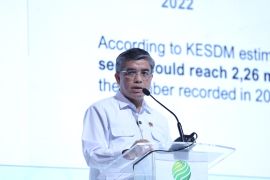"A growth of almost 8 percent is quite good amid the current crisis."Jakarta (ANTARA) - Using their native wisdom, culturally-rich Indonesians have practiced environmental preservation and sustainable development activities since ancient times.
According to the World Fish Center, Indonesia has the largest number of and longest enduring traditional community-based coastal resource management systems in Southeast Asia.
Maluku Province, for instance, has local tradition called "Sasi Laut" - the local institution under which some fishing activities are regulated. "Sasi" is nested in traditional culture, called adat, which lays down the basic ethics and codes of conduct.
And at Pemuteran village in West Bali, for example, the local community set up a foundation called Karang Lestari that assists in the preservation of coral reefs and turtle breeding.
Benefiting local traditions and advanced technologies, the government plans to promote environmental-friendly tourism that will include activities related to energy efficiency, biodiversity preservation and green jobs.
For that purpose, the tourism and creative economics ministry has made a Strategic Plan on Sustainable Tourism and Green Jobs which was officially released during a conference on sustainable tourism development held in Bali, September 13, 2012.
Deputy Minister of Tourism and Creative Economics Sapta Nirwandar during the launch of the strategic plan said the new program would revive the local traditions that could assist in promoting sustainable tourism activities.
To do so, the tourism and creative economy ministry will establish cooperation with several international organizations, such as the World Tourism Organization (UNWTO) and the International Labor Organization (ILO).
The G20 and Rio+20 have emphasized the importance of tourism in supporting sustainable development throughout the world, he added.
At the G20 Summit which was held in Los Cabos, Mexico, June 18-19, 2012 it was explicitly stated in the Leaders` Declaration that tourism is a sector that significantly contributes to the economic growth of nations, along with job opportunities.
And it is also the case with Indonesia which expects at least US$ 9 billion to be contributed by international tourist arrivals to Indonesia`s foreign exchange this year.
According to Central Bureau of Statistics (BPS) data, 3,876,310 foreign tourists visited Indonesia during the January-June 2012 period, an increase of 7.75 percent from the 3,597,632 tourists seen in the same period last year.
Tourism and Creative Economy Minister Mari Elka Pangestu last August explained that the almost 8 percent rise in foreign tourist arrivals in Indonesia was "a good indication" because the figure was above the global average.
"A growth of almost 8 percent is quite good amid the current crisis," Mari pointed out.
"The 8 percent growth in Indonesia is similar to the average increase in foreign tourist arrivals across the Asia-Pacific region, but higher than the global average of 5 percent," Mari noted.
She expressed optimism that Indonesia can achieve its target of attracting 8 million tourists this year.
During the first half of 2012, the five major suppliers of tourists to Indonesia were Singapore (with 615,390 tourists, up 1.1 percent from last year), Malaysia (557,413, up 10.1 percent), Australia (422,787, up 6.1 percent), China (305,303, up 33.5 percent), and Japan (200,093, up 5 percent).
There was also a significant increase in the number of tourists coming from China, Egypt, Thailand, Saudi Arabia, the Philippines, Russia, and Bahrain.
The ministry has also set a target of 245 million trips, for domestic tourists, who are expected to spend Rp171.5 trillion (US$18 billion).
"We also see a rise in the number of domestic tourists because the purchasing power of Indonesians has increased and their spending is double that of foreign tourists," Mari stated.
In the first half of this year, domestic tourists spent a total of US$9 billion. Last year, domestic tourists made 236.752 million trips, spending a total of Rp156.89 trillion.
To promote the country`s tourism industry, the government. among other things, has designated 10 rural areas as national tourism villages.
One of the 10 tourism villages is Kampoeng Batik Kauman (Kauman Batik Village) in Pekalongan, Central Java.
"Kampoeng Batik Kauman has been included in the top ten national tourism villages by the Tourism and Creative Economy Ministry," the head of Pekalongan City Transportation, Tourism and Culture Office, Doyo Budi Wibowo, said recently.
The assessment and consideration on the top 10 national tourism villages were based on the effective use of the National Program for Community Empowerment (PNPM) on tourism in 2011.
The other rural areas which have been named tourism villages are Bajiharjo (Gunung Kidul district in Yogyakarta), Banjarsari (Kulon Progo district in Yogyakarta), Dieng Kulon (Banjarnegara district in Central Java), Karangbanjar (Purbalingga district in Central Java), Bungus Selatan (Padang, West Sumatra), Pandai Sikek (Tanah Datar district, West Sumatra), Lampulo (Banda Aceh, Aceh Province), Karang Tengah (Bantul district in Yogyakarta) and Kembangarum (Sleman district in Yogyakarta).
Another attraction expected to attract tourists to come to Indonesia is world-class golf courses. The country has 152 world-class golf courses across its 33 provinces, according to Minister Pangestu.
She said Indonesia has been known in the world as one of golf tourism destinations proven by increasing number of foreign tourists coming to a number of cities in the country to play golf such as Jakarta, Bandung, Bali and even Padang in West Sumatra.
Further, Pangestu will promote 10 major Indonesian cities as tourist destinations during a series of Asia-Pacific Economic Cooperation (APEC) meetings to be hosted by Indonesia in October 2013.
"Besides the main event, we will have a series of international programs and meetings, including music and art shows and seminars," she said recently.
The 10 major cities were Lombok (West Nusa Tenggara), Medan (North Sumatra), Palembang (South Sumatra), Yogyakarta, Bandung (West Java), Jakarta, Manado (North Sulawesi), Makassar (South Sulawesi), Semarang (Central Java), and Surabaya (East Java).
Although the APEC Summit itself will be held in Bali, the idea behind holding the other meetings in major cities outside the province is to promote the potential of the country as a whole in order to boost the tourism industry and creative economy, she explained.
"This is a good opportunity for Indonesia," Mari noted, adding that "When the APEC meeting will be held in Surabaya, for example, we will promote Mount Bromo and the Batu tourist resort, among other things."
In 2011, foreign tourist arrivals to Indonesia reached 7.65 million, up 9.24 percent from that in 2010. It generated foreign exchange earnings of US$ 8.55 billion or an increased of 12.51 percent compared to the year 2010.
Indonesia`s foreign tourist arrivals contributed 0.58 percent share of the world tourist arrival in 2006 and increased to 0.78 percent in 2011; 2.93 percent of Asia Pacific in 2006 and surged to 3.52 percent in 2011; and 9.17 percent of Southeast Asia in 2006 and up 9.92 percent in 2011 .
Last year, tourism contributed 4.06 percent to the National GDP, 6.87 percent to the total national workforce or 7.44 million people, and Rp9.35 trillion to the indirect taxes.
(T. F001/H-YH)
Reporter: by Fardah
Editor: Priyambodo RH
Copyright © ANTARA 2012










